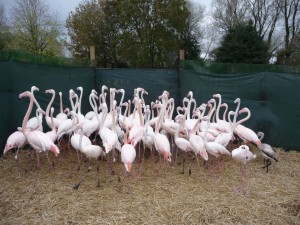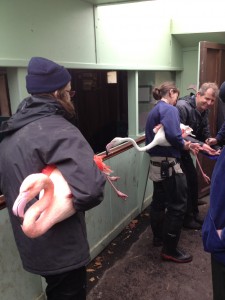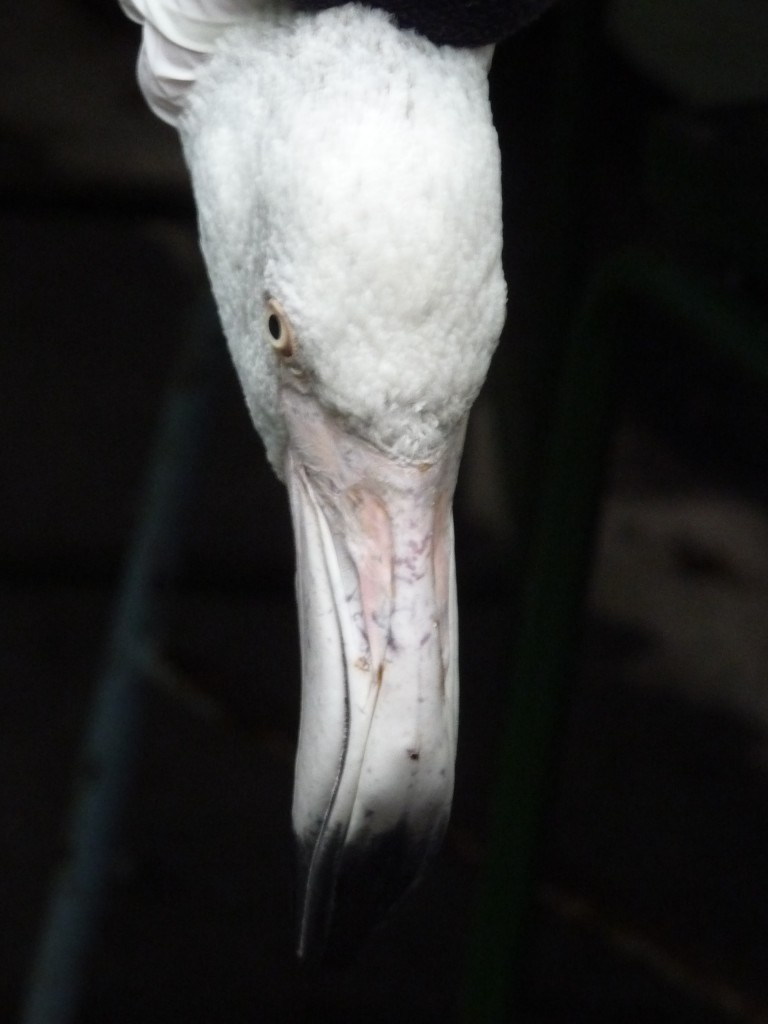Flamingo round-up at Martin Mere
Yesterday at WWT Martin Mere in Lancashire, a group of willing flamingo keepers, volunteers and aviculturists gathered to help with the round-up of the 90-strong flock of greater flamingos that reside in the big pen at the very entrance of the waterfowl gardens. The flamingos were being caught for a variety of husbandry reasons, of which I will detail below. WWT has perfected the art of flamingo catching over the years and the system that has been developed involves a leading the birds into a "corral" (a temporary fenced enclosure) and separating smaller groups off from the main flock for handling. The birds that are picked out by the handlers go to a team of “processors” to check rings, feet and microchips, as well as for weighing. This method of flamingo catching works really well for large flocks as it is relatively stress-free for the birds and means and that a flock can be caught and handled in the shortest time possible.
 So, a few things that I learned during this flamingo catch...
So, a few things that I learned during this flamingo catch...
One; flamingos are a lot heavier than they look, especially the big, tall males, and when they want to put up a fight you'd better watch out! They especially enjoy chewing on your ear lobes as they are being carried. You can see in the photo how birds are held pointing behind the carrier and in this position you have to make sure that you know where their head is! Your natural instinct is to keep a firm grip on the bird, but if you do that, it can make it struggle all the more. So it takes time to master the confidence to let it wriggle a little, whilst knowing you still have hold of it.
Two; getting your hands in the right place to keep their legs separated from each other is harder than it looks! Duane from WWT Slimbridge and Steve from WWT Martin Mere having been practised numerous times, make it appear all so simple. But it can take time to master. When carried, a flamingo must be kept with its legs pointing below the horizon to maintain adequate blood flow to extremities. If the circulation is compromised, then that makes for one very unhappy flamingo.
 Three; putting a flamingo into a transport crate means keeping a hold of it until the bird is standing up by itself. Ten birds have been sent down from Martin Mere to Slimbridge to augment the ever-growing flock in the new "Flamingo Lagoon" exhibit. These ten lucky holiday-makers were to be transported in tall, sack-lined, comfy transport crates and as the birds are lowered in from the top, they had to feel their feet on solid ground before they would stand by themselves. So it was important to keep a hold of them until they had quite literally "found their feet".
Three; putting a flamingo into a transport crate means keeping a hold of it until the bird is standing up by itself. Ten birds have been sent down from Martin Mere to Slimbridge to augment the ever-growing flock in the new "Flamingo Lagoon" exhibit. These ten lucky holiday-makers were to be transported in tall, sack-lined, comfy transport crates and as the birds are lowered in from the top, they had to feel their feet on solid ground before they would stand by themselves. So it was important to keep a hold of them until they had quite literally "found their feet".
Four; the team of people working at both Centres were incredibly professional, patient and well-coordinated. The whole catch-up took about three hours in total and everybody knew precisely what they were doing. No birds suffered in any way during the experience and by lunchtime, the flock were all back inside their house preening, feeding and bathing. A happy and contented group of flamingos not at all bothered by the ring checks, foot photographs and weighing that had just taken place.
And as for those birds travelling down to WWT Slimbridge? Well they all arrived safely and in good time to settle in before nightfall, Phil having left Martin Mere earlier than everyone else as soon as the ten allotted birds had been caught. When moving flamingos, it is important that they get chance to bathe, preen and drink during the settling in process and then they are able to bond with their new flock mates happily. So look out for a few birds when you next visit Slimbridge "DH" and "CV" are two notable individuals from up north that now live down south!
If you'd like to see more photos from the catch, then check out the Flamingo Specialist Group page on Facebook where an album of photos from the day has been uploaded. http://www.facebook.com/FlamingoSpecialistGroup




